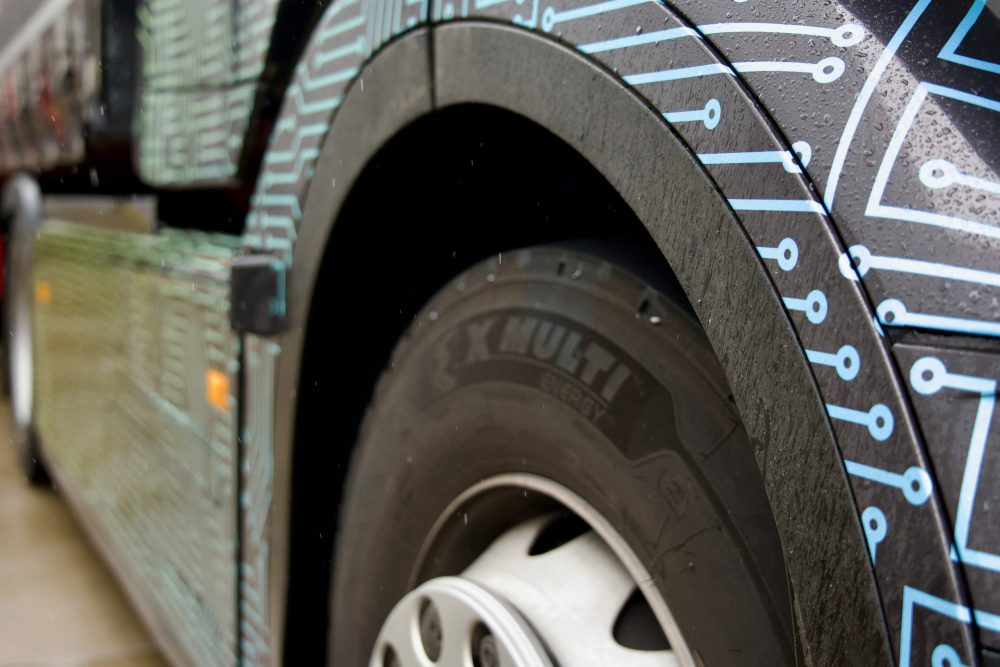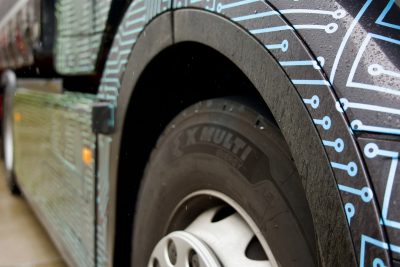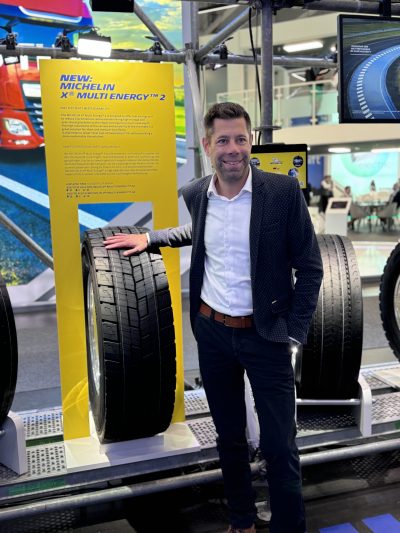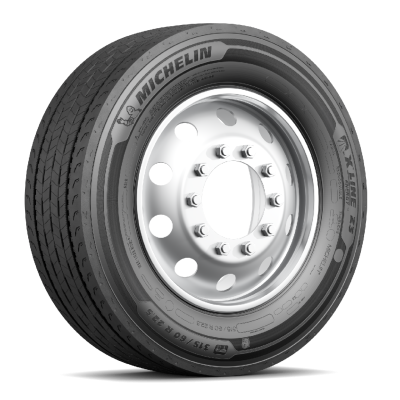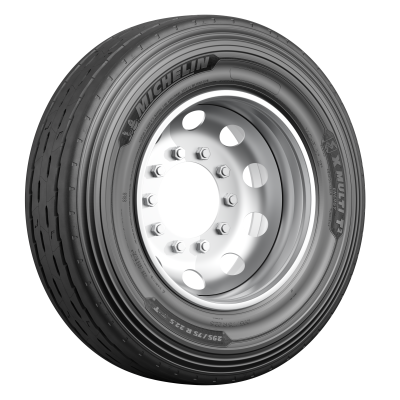Michelin used the occasion of IAA Transportation 2024 to launch two new generations of truck tyres that combine fuel savings with high mileage, reduced tyre abrasion and enhanced reliability.
The MICHELIN X® LINE ENERGY™ 3 and MICHELIN X® MULTI ENERGY™ 2 are designed for long-haul and regional transport respectively, bringing new levels of fuel efficiency and sustainability.
Philipp Ostbomk, Vice President B2B Europe North, Michelin, says: “With the new tyres, Michelin is once again demonstrating its technological lead in terms of manufacturing tyres with an ultra-low rolling resistance, and a reduced environmental footprint. Both products can also be regrooved and retreaded, ensuring fleets can extract the maximum performance from each new Michelin casing. This helps our customers reduce their operating costs in a highly competitive market and contribute to more sustainable mobility.”
Long-haul transport with energy efficiency class A
The MICHELIN X® LINE ENERGY™ 3 for steer and drive axles is available in two popular sizes for high-volume transport tasks: 315/60 R 22.5 X® LINE ENERGY™ Z3 and 295/60 R 22.5 X® LINE ENERGY™ D3.
The tyres are the first long-haul tyres in the 60 series to be A-rated for fuel efficiency. This puts them at the forefront of 60-series long-haul tyres in terms of fuel savings, cutting fuel consumption by up to 0.62 litres per 100 kilometres, versus the average of the tested competitors1.
- Fuel cost savings: fleets can save between €700 and €2,200 on fuel per truck, per year, with these tyres1. Figures are based on a reduction in fuel consumption of 0.3 to 0.9 litres per 100 kilometres over an annual distance of 150,000 kilometres, with a diesel price of €1.65 per litre.
- Reduced CO2 emissions: the enhanced fuel efficiency of the MICHELIN X® LINE ENERGY™ 3 reduces CO2 emissions by up to three tonnes compared to the average of competitors with an annual mileage of 150,000 kilometres2.
- Less tyre abrasion: the MICHELIN X® LINE ENERGY™ 3 also produces at 3.4 kilograms less tyre abrasion than the average of its premium segment competitors3.
- Grip: the MICHELIN X® LINE ENERGY™ 3 also brings more grip to the road: The lateral grip is 4.42% better when new and 2.02% better when worn4 (at 33% tread depth) compared to the previous range5.
- Mileage: what’s more, MICHELIN was able to improve the mileage potential of the MICHELIN X® LINE ENERGY™ 3 by 3% compared to the previous range6.
Versatile for mixed applications
MICHELIN X® MULTI ENERGY™ 2 tyres for steer and drive axles are available in two main sizes: 315/70 R 22.5 X® MULTI ENERGY™ Z2 & D2, and 315/80 R 22.5 X® MULTI ENERGY™ Z2 & D2. The new generation of tyres has been specially designed for trucks and can be used in a wide range of applications, including on motorways, multi and single carriageways.
- Fuel and cost savings: fuel consumption of the MICHELIN X® MULTI ENERGY™ 2 is up to 1.2 litres lower compared to the MICHELIN X® MULTITM. This enables cost savings of up to €1,800 per year7.
- Reduced CO2 emissions: the MICHELIN X® MULTI ENERGY™ 2 produces up to 0.52 tonnes less CO2 emissions per 100,000 kilometres, per year, compared to competitors8.
- Grip: the lateral grip of the MICHELIN X® MULTI ENERGYTM 2 is 5.06% higher with new tyres and 5.67% higher with worn tyres4 compared to the previous range9.
- Less tyre abrasion: MICHELIN X® Multi Energy™ 2 produces 7.1 kilograms less tyre abrasion than the average of its competitors over a distance of around 54,000 kilometres10.
- Performance: the MICHELIN X® MULTI ENERGYTM 2 offers significantly better overall performance compared to the MICHELIN X® MULTI ENERGYTM – with high mileage at the same time.
High-tech on board
The two new generations of MICHELIN X® LINE ENERGY™ 3 and MICHELINX ® MULTI ENERGY™ 2 truck tyres have a robust, lightweight and flexible carcass. This is based on MICHELIN technologies which enable high mileage, durability and, in conjunction with the new tread design, low rolling resistance.
- INFINICOIL technology ensures a stable belt structure: A steel cable wrapped around the crown block, up to 400 metres long (depending on the tyre size), increases its strength and ensures an optimised ground contact surface throughout the entire service life. This increases the mileage and reduces fuel consumption thanks to lower rolling resistance.
- POWERCOIL technology uses a new generation of high-strength fine wire ropes in the carcass. These make the tyre resistant to deformation and damage and reduce rolling resistance and thereby fuel consumption.
- REGENION technology enables self-regenerating tread blocks that provide grip throughout the service life of the tyre. This sees new grooves created for improved mobility as the tyre wears. REGENION results in low tread deformation, low rolling resistance and therefore low fuel consumption.
- DURACOIL technology helps extend the life of the carcass by improving the transition between the tyre and wheel. During use, high quality nylon protects the bead area and provides improved stability for the bead tip. This reinforcement improves the durability of the carcass and the acceptance for retreading.
1 Michelin internal fuel consumption tests by comparison with the competitors. Duration: 65,975 km on an open toll road in the south of Spain. April – June 2024 under Dekra supervision (Report 23CPA11-239 available here: https://business.michelin.co.uk/reduce-your-costs-and-carbon-footprint-thanks-to-the-new-generations-of-michelin-tyres). MICHELIN X® Line Energy™ Z3 & X® Line Energy™ D3, Continental Ecoplus HS3+ & HD3+. Bridgestone Ecopia H-Steer 002 & Ecopia H-Drive 002, Goodyear FUELMAX S Endurance & FUELMAX D mounted on the same Volvo FH500 I-Save trucks, carrying a 40 tonne load. Fuel savings measured on the basis of fuel consumption while the vehicle was being driven (Source: Volvo Connect KPI = fuel L/100 km). Actual consumption during testing: with MICHELIN X® Line Energy™ Z3 & X® Line Energy™ D3 = 30.30L/100km Continental Ecoplus HS3+ & HD3+ 30.90L/100km. Bridgestone Ecopia H-Steer 002 & Ecopia H-Drive 002 = 30.60L/100km and Goodyear FUELMAX S Endurance & FUELMAX D = 31.25L/100km, therefore competitor’s average consumption: 30.92L/100km. Average difference in consumption by comparison with the competitors 30.92 – 30.30 = 0.62L/100km. Based on the cost of diesel at €1.65/L and an average distance per truck and per year in long-distance usage of 150,000 km, estimated savings per truck = calculated at €1,534. 0.62×1,500x€1.65 = €1,534.
2 Michelin internal fuel consumption tests by comparison with the competitors. Driven for 65,975 km on an open toll road in the south of Spain. April – June 2024 under Dekra supervision (Report 23CPA11-239 available here: https://business.michelin.co.uk/reduce-your-costs-and-carbon-footprint-thanks-to-the-new-generations-of-michelin-tyres). 315/60R22.5 & 295/60R22.5: MICHELIN X® Line Energy™ Z3 & X® Line Energy™ D3, Continental Ecoplus HS3+ & HD3+. Bridgestone Ecopia H-Steer 002 & Ecopia H-Drive 002, Goodyear FUELMAX S Endurance & FUELMAX D mounted on identical Volvo FH500 I-Save trucks, carrying a 40 ton load. CO² savings calculated on the fuel consumption findings. X® Line Energy™ 3 fuel consumption of 0.62 L/100km (3) is lower than the competitors’ average. Fuel savings measured on the vehicles’ fuel consumption while being driven (source: Volvo Connect indicator = Liter of diesel fuel/100 km while the vehicle is being driven).
Fuel savings measured on the vehicles’ fuel consumption while being driven (source: Volvo Connect indicator = Liter of diesel fuel100 km). The MICHELIN vs competitors. Actual consumption figures during the tests:
MICHELIN X® Line Energy™ Z3 & X® Line Energy™ D3 = 30.30L/100km
Continental Ecoplus HS3+ & HD3+ 30.90L/100km
Bridgestone Ecopia H-Steer 002 & Ecopia H-Drive 002 = 30.60L/100km
Goodyear FUELMAX S Endurance & FUELMAX D = 31.25L/100km
Therefore competitors’ average fuel consumption = 30.92L/100km.
Average difference in consumption vs competitors: 30.92 – 30.30 = 0.62L/100km. Calculation based on the absolute kg of CO2/100km = Diesel: 3.38 kg CO2 eq / Litre4 & an average distance travelled, in long-distance haulage applications, of 150,000 km per truck per year, kg of CO2/100km per brand:
With MICHELIN X® Line Energy™ Z3 & X® Line Energy™ D3 = 30.3L/100km, 30.3x 3.38 = 102.41 kg de CO2/100km. 102.41 x 1,500/1,000 = 153.62 tonnes de CO2 per 150,000km. Continental Ecoplus HS3+ & HD3+; 30.90L/100km = 30.90×3.38 = 104.44 kg de CO2/100km. 104.44 x 1,500/1,000 = 156.66 tonnes de CO2 per 150,000km. Bridgestone Ecopia H-Steer 002 & Ecopia H-Drive 002; 30.60L/100km = 30.60×3.38 = 103.43 kg de CO2/100km. 103.43 x 1,500/1,000 = 155.14 tonnes de CO2 per 150,000km. Goodyear FUELMAX S Endurance & FUELMAX D = 31.2L/100km = 31.20×3.38 = 105.46 kg de CO2/100km. 105.46 x 1,500/1,000 = 158.18 tonnes de CO2 per 150,000km.Therefore the competitors’ average CO2 production = 156.66 CO2 tonnes. And the average of the CO2 gains vs competitors = 3 tonnes of CO2 (156.66-153.62=3.04)
Index for converting L of diesel into kg of CO2: taken from the Ecoinvent 3.9 database and calculated with the EF 3.1 impact assessment method – Diesel: 3.38 kg CO2 equivalent / L.
3 Michelin internal tests on mass loss against competitors against competitors in south of Spain on open highway. Duration 65 975km, except for the Bridgestone tyres, which covered 53,334 kms due to poor wear. April – June 2024 under Dekra supervision (Report 23CPA11-239 available here: https://business.michelin.co.uk/reduce-your-costs-and-carbon-footprint-thanks-to-the-new-generations-of-michelin-tyres). 315/60R22.5 & 295/60R22.5: MICHELIN X® Line Energy™ Z3 & X® Line Energy™ D3, CONTINENTAL Ecoplus HS3+ & HD3+. BRIDGESTONE Ecopia H-Steer 002 & Ecopia H-Drive 002, GOODYEAR FUELMAX S Endurance & FUELMAX D fitted on same trucks Volvo FH500 I-Save, fully loaded at 40 tons. FH500 I-Save.
MICHELIN X® Line Energy™ Z3 + X® Line Energy™ D3 mass loss in 65 975km: 14,16kg.
CONTINENTAL Ecoplus HS3+ & HD3+ mass loss 65 975km = 17,09kg.
BRIDGESTONE Ecopia H-Steer 002 & Ecopia H-Drive 002 mass loss 53 334km= 16,55kg.
GOODYEAR FUELMAX S Endurance & FUELMAX D mass loss 65 975km = 18,98 kg
Average competitors mass loss 17,09+16,55+18,98/3=17,54kg. Therefore 3,4kg more than Michelin (17,54-14,16=3,4kg).
4 ‘Worn’ means mechanically abraded in accordance with the American Society for Testing and Materials (ASTM) Standards F 1046 – 01 (2008).
5 6%* better in lateral grip than average competitors, with new tyres, 10%* better in lateral grip than average competitors, with worn tyres.
* Internal MICHELIN study carried at MICHELIN TECHNOLOGY CENTER Ladoux (France) May 2024 under DEKRA supervision (Report 23CPA11-239 available here: https://business.michelin.co.uk/reduce-your-costs-and-carbon-footprint-thanks-to-the-new-generations-of-michelin-tyres). Ring 110 m radius on a wet surface, water height 2,5mm with 3 identical rigid trucks Volvo FM12 with full load (19 tons) fitted with 315/60R22.5 & 295/60R22.5 new and worn tyres at same stage of wear (approx. 5mm) with identical pressure (front 9.0b ; rear: 8.0.b)
MICHELIN X® Line Energy™ Z3 & X® Line Energy™ D3 vs following competitors: Continental Ecoplus HS3+ & HD3+. Bridgestone Ecopia H-Steer 002 & Ecopia H-Drive 002, Goodyear FUELMAX S Endurance & FUELMAX D.
Time lap in seconds with new tyres: Michelin X® Line Energy™ Z3 & X® Line Energy™ D3 in 36,7 seconds, Continental Ecoplus HS3+ & HD3+ in 39,57 seconds, Bridgestone Ecopia H-Steer 002 & Ecopia H-Drive 002 in 38,09 seconds and Goodyear FUELMAX S Endurance & FUELMAX D in 39,42 seconds so in average with competitors tyres in 39 seconds. Michelin is therefore 6% faster.
Time lap in seconds with worn tyres: Michelin X® Line Energy™ Z3 & X® Line Energy™ D3 in 38,2 seconds, Continental Ecoplus HS3+ & HD3+ in 42,8 seconds, Bridgestone Ecopia H-Steer 002 & Ecopia H-Drive 002 in 42,5 seconds and Goodyear FUELMAX S Endurance & FUELMAX D in 40,7 seconds so in average with competitors tyres in 42 seconds. Michelin is therefore 10% faster.
Actual results may vary in real life conditions/depending on road and/or weather conditions.
6 Michelin is running internal tests of mileage performance for comparison with the previous X LINE ENERGY tire. Duration: 65,975 km on a toll road in the south of Spain. April – June 2024 under Dekra supervision (Report 23CPA11-239 available here: https://business.michelin.co.uk/reduce-your-costs-and-carbon-footprint-thanks-to-the-new-generations-of-michelin-tyres). 315/60 R 22.5 & 295/60 R 22.5: MICHELIN X® Line Energy™ Z3 & X® Line Energy™ D3 vs 315/60 R 22.5 & 295/60 R 22.5: MICHELIN X® Line Energy™ Z & X® Line Energy™ D. Projected mileage: X® Line Energy™ Z3 & X® Line Energy™ D3: 182,263kms, X® Line Energy™ Z & X® Line Energy™ D: 176,779kms. Accordingly the new X® Line Energy™ 3 range yields an additional 3% mileage.
7 1,800 €/year in fuel savings: internal study based on the calculation of the TCO2 tool (Vecto), 2024; comparison of 315/70 R 22.5 MICHELIN X® Multi Energy™ Z2 & D2 + 385/55 R 22.5 MICHELIN X® Multi T2 with tractor unit 315/70 R 22.5 MICHELIN X® Multi Z & D + 385/55 R 22. 5 MICHELIN X® Multi T2, fully loaded 40 t, 50% long-haul/50% regional haul, 100,000 km/ year, energy costs: €1.5/l, on average for the first life cycle, MICHELIN X® Multi Energy™ 2 vs MICHELIN X® Multi: 1.2 l/100 km less, calculation = (1.2 x 1.5) x (100,000/100) = €1,800/year.
8 Michelin ranked No.1 for CO2 savings, X® Multi Energy™ 2, 0.52 tonne of CO2 (1) vs the competitors’ average. Michelin internal fuel consumption tests by comparison with the competitors. Driven for 53,999kms on an open toll road in the south of Spain. April – July 2024 under Dekra supervision (Report 23CPA11-239 available here: https://business.michelin.co.uk/reduce-your-costs-and-carbon-footprint-thanks-to-the-new-generations-of-michelin-tyres).
315/70R22.5 MICHELIN X® Multi Energy™ Z2 & X® Multi Energy™ D2, CONTINENTAL EcoRegional HS3+ & HD3+. BRIDGESTONE Duravis R-Steer 002 & Duravis R-Drive 002, GOODYEAR FUELMAX S Endurance & FUELMAX D endurance, HANKOOK Smartflex AL 51 & DL51 mounted on identical Volvo FH500 I-Save vehicles, carrying a 40 tonne load. CO2 savings calculated on the fuel consumption findings. CO2 savings achieved through XMULTI ENERGY 2 results, fuel consumption is 0,16 L/100 km(3) lower than that of the competition. Fuel savings measured on the basis of fuel consumption while the vehicle is driven (Source: Volvo Connect KPI = fuel L/100 km when driven).
Fuel savings measured on the basis of fuel consumption while the vehicle was being driven (Source: Volvo Connect KPI = fuel L/100 km). Michelin by comparison with the competition. Actual consumption during testing:
MICHELIN X® Multi Energy™ Z2 & X® Multi Energy™ D2 = 33.71/100km
CONTINENTAL Ecoregional HS3+ & HD3+ 33.89L/100km
BRIDGESTONE Duravis R-Steer 002 & Duravis R-Drive 002 = 33.77L/100km
GOODYEAR FUELMAX S Endurance & FUELMAX D endurance =33.94L/100km
HANKOOK Smartflex AL 51 & DL51: 33.86L/100km.
As a result, the competitors’ average fuel consumption is: 33.87L/100km. Average difference in consumption by comparison with the competitors: 33.87 – 33.71 = 0.16L/100km. Calculation based on the absolute kg of CO2/100km = Diesel: 3.38 kg CO2 eq / Litre(4) & average distance per truck and per year for 100,000 km of regional transport, absolute kg of CO2/100km per brand: With MICHELIN X® Multi Energy™ Z2 & X® Multi Energy™ D2 = 33.71/100km, 33.71x 3.38 = 113.94 kg of CO2/100km. 113.94 x 1,000/1,000 = 113.94 tonnes de CO2 per 100,000km. CONTINENTAL EcoRegional HS3+ & HD3+; 33.89L/100km = 33.89 x 3.38 = 114.55 kg of CO2/100km. 114.55 x 1,000/1,000 = 114.55 tonnes of CO2 per 100,000km. BRIDGESTONE Duravis R-Steer 002 & Duravis R-Drive 002; 33.77L/100km = 33.77×3.38 = 114.14 kg of CO2/100km. 114.14 x 1,000/1,000 = 114.14 tonnes of CO2 per 100,000km. GOODYEAR FUELMAX S Endurance & FUELMAX D Endurance=33.94L/100km= 33.94×3.38 = 114.72 kg of CO2/100km. 114.72 x 1,000/1,000 = 114.72 tonnes of CO2 per 100,000km. HANKOOK Smartflex AL 51 & DL51 = 33.86×3.38 = 114.45 kg of CO2/100km. 114.45 x 1,000/1,000 = 114.45 tonnes of CO2 per 100,000km.
As a result, on average the competitors produce: 114.46 tonnes of CO2. And the average CO2 reductions by comparison with the competitors is 0.52 tonne of CO2 (114.46-113.94=0.52).
Index for converting L of fuel into kg of CO2: taken from the Ecoinvent 3.9 database and calculated with the EF 3.1 impact assessment method – Diesel: 3.38 kg CO2 eq / L.
9 Internal MICHELIN study carried at MICHELIN TECHNOLOGY CENTER Ladoux (France) May 2024 under DEKRA supervision (Report 23CPA11-239 available here: https://business.michelin.co.uk/reduce-your-costs-and-carbon-footprint-thanks-to-the-new-generations-of-michelin-tyres). Ring 110 m radius on a wet surface, water height 2,5mm with 3 identical rigid trucks Volvo FM12 with full load (19 tons) fitted with 315/70R22.5 new and worn, tyres at same stage of wear (approx. 5mm) with identical pressure (front 8.5b; rear: 7.5.b). MICHELIN X® Multi Energy™ Z2 & D2 vs following competitors Continental EcoRégional HS3+ & HD3+. Bridgestone Duravis R-Steer 002 & Duravis R-Drive 002, Goodyear FUELMAX S Endurance & FUELMAX D Endurance and Hankook Smartflex AL51 & DL51.
Time lap in seconds with new tyres: Michelin X® Multi Energy™ Z2 & D2 in 36,5 seconds, BRIDGESTONE Duravis R Steer 002 & Drive in 37,3 seconds, GOODYEAR FUELMAX S ENDURANCE & D in 38,2 seconds, CONTINENTAL EcoRégional HS3+ & HD3+ in 39 seconds and Hankook Smartflex AL51 & DL51 in 39,1 seconds so in average competitors tyres in 38,4 seconds. Michelin is therefore 5% faster.
Time lap in seconds with worn tyres: Michelin X® Multi Energy™ Z2 & D2 in 37,9 seconds, BRIDGESTONE Duravis R Steer 002 & Drive in 41,1 seconds, GOODYEAR FUELMAX S ENDURANCE & D in 42,2 seconds, CONTINENTAL EcoRégional HS3+ & HD3+ in 41,8 seconds and Hankook Smartflex AL51 & DL51 in 41,5 seconds so in in average with competitors tyres in 41,6 seconds. Michelin is therefore 10% faster.
Actual results may vary in real life conditions/depending on road and/or weather conditions.
10 Michelin internal tests on mass loss against competitors. Duration 53 933km, in south of Spain on open roads. April – July 2024 under Dekra supervision ((Report 23CPA11-239 available here: https://business.michelin.co.uk/reduce-your-costs-and-carbon-footprint-thanks-to-the-new-generations-of-michelin-tyres). With identical trucks Volvo FH500 I-Save, fully loaded at 40 tons fitted with 315/70R22.5 MICHELIN X® Multi Energy™ Z2 & D2 vs following competitors: Continental EcoRégional HS3+ & HD3+, Bridgestone Duravis R-Steer 002 & Duravis R-Drive 002, Goodyear FUELMAX S Endurance & FUELMAX D Endurance and Hankook Smartflex AL51 & DL51.
MICHELIN X® Multi Energy™ Z2 & plus X® Multi Energy™ D2 total mass loss in 53 933km: 19,31kg.
Continental EcoRégional HS3+ plus EcoRégional HD3+ total mass loss in 53 933km = 32,43kg.
Bridgestone Duravis R-Steer 002 plus Duravis R-Drive 002 total mass loss 53 258km= 22,14kg.
Goodyear FUELMAX S Endurance plus FUELMAX D Endurance total mass loss 53 258km = 28,84 kg.
Hankook Smartflex AL51 plus Smartflex DL51 total mass loss 53 258km = 22,15 kg.
Average competitors mass loss 32,43+22,14+28,84+22,15/4=26,39kg. Therefore 7,1kg more than Michelin (26,39-19,31=7,1kg).
For more news and images, visit news.michelin.co.uk.
About Michelin
Michelin is building a world-leading manufacturer of life-changing composites and experiences. Pioneering engineered materials for more than 130 years, Michelin is uniquely positioned to make decisive contributions to human progress and to a more sustainable world.
Drawing on its deep know-how in polymer composites, Michelin is constantly innovating to manufacture high-quality tyres and components for critical applications in demanding fields as varied as mobility, construction, aeronautics, low-carbon energies, and healthcare.
The care placed in its products and deep customer knowledge inspire Michelin to offer the finest experiences. This spans from providing data- and AI-based connected solutions for professional fleets to recommending outstanding restaurants and hotels curated by the MICHELIN Guide.
CONTACT
Zoe Axdorph
Press Officer Nordics & UK
+46 (0) 79 142 71 23
zoe.axdorph@michelin.com
Ringvägen 100, 118 60 Stockholm, Sweden



